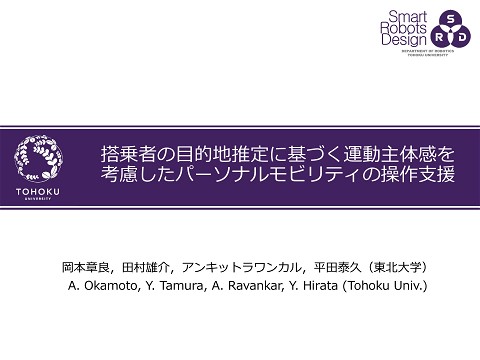Estimation of Handgrip Position Based on Force Measurement During Steady Pedaling (World Congress of Cycling Science 2015)
172 Views
March 17, 22
スライド概要
Yusuke Tamura, Kojiro Matsushita, Hisashi Osumi, "Estimation of Handgrip Position Based on Force Measurement During Steady Pedaling," Journal of Science and Cycling, Vol.4, No.2 (World Congress of Cycling Science 2015), pp.71-72, 2015.
東北大学大学院工学研究科ロボティクス専攻 田村研究室
関連スライド
各ページのテキスト
Estimation of Handgrip Position Based on Force Measurement During Steady Pedaling 1 2 Yusuke TAMURA , Kojiro MATSUSHITA , Hisashi OSUMI 1 The 3 University of Tokyo 2 Gifu University 3 Chuo University [email protected] Introduction There have been many studies on pedaling skills to improve cycling efficiency (Bini et al., 2013). Riding position of upper body as well as leg motion is very important for cycling because it has a substantial impact on air resistance and physical fatigue (Burke & Pruitt, 2003). Although camera-based motion capture systems are the most popular solution to measure riders’ position during cycling, they limit the range of motion and cannot be applied to actual outdoor cycling. In this study, we aim for developing a bike-mountable position estimation system. For this purpose, as a first step, we propose a method for estimation of handgrip position based on the force measurement during steady pedaling. Methods Preliminary experimental results Equipments Estimation method Three parameters (FX, FY, MX) were chosen for the estimation. The proposed method classifies the observed data into three classes corresponding to the positions of handgrip, such as drops, hoods, and tops based on the SVM (Support Vector Machine; Cortes & Vapnik, 1995). 6-axis force/torque sensor (BFS067XS102EU6S, Leptrino) Fz: ±1000N, Fx/Fy: ±500N Mx/My/Mz: ±40Nm SVM Wattbike Trainer (Wattbike Ltd.) Feature vector: x = (FY 0 , FZ 0 , MX 0 ) Discriminant function: N X f (x) = an tn k(x, xn ) + b Drops n=1 Hoods Kernel: Radial Basis Function Y -‐10 -‐150 X -‐15 Z Y MX (Nm) FZ (N) -‐175 -‐200 80 -‐20 100 120 140 80 FY (N) Participants : Kernel parameter 140 -‐225 FY (N) -‐200 -‐175 -‐150 FZ (N) one-against-one method was used for three classes Procedure Four amateur male cyclists (mean 45.5 years old) participated in the experiments. The pedaling load and cadence were set according to each participant’s preference. Learning phase: To construct an SVM classifier, 60 seconds learning data for each handgrip position was collected at 100 Hz for each participant. Test phase: Participants changed their handgrip positions every 30 seconds and steadily pedaled 6 minutes in total. Results & Discussion The proposed method achieves both high precision and recall. actual handgrip position estimated handgrip position Participant A Hoods True\Estimated Drops Hoods Tops Release Recall (%) Drops 40980 79 6974 0 85.3% 0 Examples of estimation Drops Confusion matrix Hoods 120 xn k2 N : Number of the learning data b : Bias -‐20 -‐25 100 kx an : Lagrange’s undeteremined multiplier tn : Class label corresponding to the n-th learning data xn -‐15 -‐25 -‐225 k(x, xn ) = exp -‐10 MX (Nm) Tops 48107 151 0 Tops Release 0 99.7% Tops 4 11 47563 0 100.0% Release 18 96 575 496 41.9% Precision (%) 99.9% 99.6% 86.1% 100.0% 100 Participant B Time (s) 200 300 Drops Hoods Tops 0 100 Time (s) 200 300 For 3 participants, the proposed method could estimate their handgrip positions accurately. For 1 participant (Participant B), the method did not properly work. Because his riding form during the test phase might be quite different from the form during the learning phase. To improve the performance, we will try to - increase the learning data - explore new feature value less affected by the riding forms Conclusion We proposed a method to estimate handgrip position based on the force measurement. The proposed method can estimate the handgrip position with high reliability during steady pedaling. For future works, we will apply our system and estimation method to normal road bikes and develop a method to estimate positions of cyclists’ upper body. References R. B. Bini, P. Hume, J. Croft, A. Kilding, Pedal force effectiveness in cycling: a review of constraints and training effects, Journal of Science and Cycling, Vol.2 (1), 11-24, 2013. E. R. Burke, A. L. Pruitt, Body Positioning for Cycling, High-Tech Cycling second edition, E. R. Burke (ed.), pp.69-92, Human Kinetics, 2003. C. Cortes, V. Vapnik, Support-Vector Networks, Machine Learning, Vol.20, pp.273-297, 1995. C-C. Chang, C-J. Lin, LIBSVM: A Library for Support Vector Machines, ACM Transactions on Intelligent Systems and Technology, Vol.2, 27:1-27, 2011. Science & Cycling Conference, 1-2 June, 2015, Utrecht





